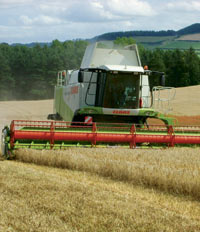‘Latest ever’ harvest looms on Farmers Weekly Barometer Farm

James Wray faces the prospect of his latest ever cereal harvest on land he farms around Dungiven, County Londonderry – thanks mainly to last year’s sodden autumn.
And with less than 15% of his crops cut by Tuesday (18 August), Sentry farm manager Mike Eagers was becoming increasingly concerned by a forecast of more bad weather for Trinlaymire Farm near Edinburgh.
Mr Wray’s only winter cereal is 34.5ha of Zebedee wheat sown at the end of February.
“It actually looks very well when you consider we nearly ploughed it in when we doubted it had vernalised.
“I’ll desiccate it tomorrow with touchdown Quattro (glyphosate), which contains stickers for a bit of security in our showery conditions.”
Tybalt spring wheat drilled in mid-March also looked well but the 40ha would not be ripe for at least three weeks, he estimated.
“After an awful autumn we badly needed a good spring but we didn’t get it.” So sowing of his 163ha of Quench, Westminster and Sweeney spring barley wasn’t finished until late May.
“Our 200 acres of potatoes were also planted a few weeks later than usual, finishing on the last week of May.”
After late sowing crops had been playing “catch up”, albeit apparently successfully, said Mr Wray.
“We’ve had a great growing summer, warm dry spells with the occasional shower. It’s been perfect for growth, but it’s also brought high disease pressure, particular potato blight; so I’m expecting variable yields.”
His combines, a TX36 and a TX62 – both 17ft cut, grain drier and baler were all ready to roll. “We’ve had more time than usual to prepare so we are hoping harvest will be a smooth operation, even though it could be later than ever before.”
Despite recent rain, ground conditions were fine for travell-ing, though his Opico 12t mobile batch drier could be “pushed”, he admitted.
Cash flow also remained a struggle. “Fuel, electricity and gas prices are slowly increasing while grain and potato prices are falling alarmingly.” One bright spot was that straw prices were strong and demand high.
Much still to do in Scotland
With just 81ha of winter barley and 120ha of oilseed rape cut, Mr Eagers was getting nervous about his Lexion 600 27ft cut combine’s ability to cope with what remained.
“Our peak workload is fast app-roaching with 70ha of red wheat, 700ha of spring barley and 600ha of winter wheat to combine. We need sustained settled weather or the window will get narrower and quality issues will rear their heads again.”
He had not ruled out repeating last year’s exercise of bringing another Sentry combine up from the south.
“I wasn’t unhappy with the barley cut at an average of 18% moisture. Volume yielded 7.5t/ha and Pearl 6.2 t/ha.
“100t of the Pearl is away on a £140/t malting contract. But the rest is in the barn and the price prospects look bleak.
“The straw was all baled and the land cleared quickly, which lulled us into a false sense of security with the weather.
“This has deteriorated ever since, with 21mm falling at the weekend followed by 10mm on Monday (17 August).
“In between we finished combining the oilseed rape, Alienor and Excalibur, which remarkably, given the rain, was cut at 15% – helped no doubt by desiccation with Quad (diquat). The yield averaged 2.75t/ha which given the conditions it was established under is a miracle.”
The red wheat needed cutting this week or Hagbergs would suffer, he feared. Spring barley would follow.
His main concern was that wet weather would stop him rectifying last year’s soil damage.
“We had hoped to undertake subsoiling to take out pan layers and generally aerate the soil where the persistent wet caused slumping.”
He also wished he had sold more barley and rape forward.
“Prices are appalling. Sentry’s policy of forward selling has paid off with 60% of total crop sold forward. Wheat, the bulk at 69%, is currently averaging £135/t. Winter barley and rape sales are on the light side and I regret not selling more. The potential for uplift is greatest on rape.
“We’ve managed to sow 55ha of Alienor, turned around very quickly after the winter barley – all bar two fields part-drilled with spring barley.
“Our cut-off sowing date is 24 August, but I won’t commit until I’m confident of settled weather.
“I sense visions and memories of last year. The week ahead is critical.”

